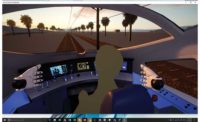Station design work continues on the $63-billion California High-Speed Rail project, while California High-Speed Rail Authority officials plan a special oversight meeting in September over a forensic report on corroded steel strands on one of the ongoing construction contracts.
The authority announced Aug. 18 that corrective action is being taken regarding Route 27, which is being built by Tutor Perini/Zachry/Parsons as part of a 29-mile section of the project in the Central Valley under a $1.4-billion contract.
The Los Angeles Times on Aug. 10 reported on a forensic engineering analysis that found that 23 strands on a bridge had corroded from rainwater that leaked into the internal structure and broke last fall. A stop-work order was issued last November. The analysis was prepared for Tutor Perini by the forensic engineering firm Wiss, Janney, Elstner Associates of Northbrook, Ill. The newspaper labeled the situation “a horrible sequence of mistakes.”
Tutor Perini responded to the LA Times in a letter: “The bridge in question, just one of more than 30 bridges in Tutor Perini’s contracted portion … had an issue with water in a few of the post-tensioning ducts. Through investigation, Tutor Perini discovered that the water made its way into the post-tensioning ducts through broken vent tubes. These tubes were found to be broken during installation by the rebar subcontractor."
The letter adds that "the breaks were small enough to not be seen, but large enough to allow water to intrude into the post-tensioning ducts, which resulted in the corrosion of the post-tensioning strands. As a result, Tutor Perini is now in the midst of an engineer-approved repair plan to replace all the strands in every post-tensioning duct. This plan has been checked by an independent engineer and reviewed and approved by the engineering staff of the California High-Speed Rail Authority."
The firm says "the total cost of the repair is nominal and is the contractual responsibility of the rebar subcontractor. Everyone associated with the engineering of the bridge believes that once the issue has been corrected the bridge will have 100% of its design capacity and there will be no impact to the overall project.”
The joint venture had received a $63-million change order in 2016 and a completion extension from 2017 to 2019. In August 2019, the authority board agreed to extend the deadline to Nov. 2, 2021, as well as add another $126 million to defray delay costs associated with securing right-of-way, utility relocations and third-party agreements, according to the CEO report that month.
The authority stated Aug. 18 that “a corrective action plan has been submitted, approved by the authority and verified by an independent third-party engineer with extensive knowledge of issues of a similar nature. Pre-construction repair work is currently underway on the structure.”
In the meantime, site selection is underway for all 21 stations on the ultimate Sacramento-San Diego alignment, with the initial four stations in the Central Valley being readied for 2028 service, said Margaret Cederoth, authority director of planning and sustainability. “After that, we are looking to extend [work] to Silicon Valley … up to the Transbay Terminal,” she said, in addressing attendees of an Aug. 18 webinar hosted by the US High-Speed Rail Association.
Many of the stations will be integrated with existing commuter lines and hubs, including the Anaheim Regional Transportation Intermodal Center, Cederoth added. In Palmdale, the long-term plan is to integrate with another planned high-speed rail line—XpressWest to Las Vegas.
In Burbank, the plan is to provide a connection to the local airport.
The stations will not resemble the “limestone edifices” of the past, such as New York’s Grand Central Terminal, she noted. “The station itself will be composed of many different parts—canopies, circulation elements, bike and pedestrian facilities, and transit-oriented development,” she said. All stations are intended to be zero-net or net-positive environmentally.
Anticipated stations are augmenting existing development plans in cities including Bakersfield. Jackie Kitchen, its assistant city manager, told webinar attendees that after settling litigation with the authority in 2014, “We started improving relationships and having important conversations about how [high-speed rail] will best benefit our community.”
The city adopted a station vision plan in 2018 that intends to build on underused parcels, increase intermodal downtown connectivity and create compact walkable space, she said.
Randy Volenec, senior project manager at Pelli Clarke Pelli Architects, noted that the high-speed rail line will enter San Francisco’s Salesforce Tower 55 ft below grade, with a Request for Proposals recently issued for fitting out the station box. The original plan had been to build the transit center grade up first, then excavate the station box, he noted.
But a $400-million grant issued under the 2009 federal ARRA program enabled a redesign to “build the ‘basement’ first, then the ‘house’ on top of it,” he noted.




Post a comment to this article
Report Abusive Comment